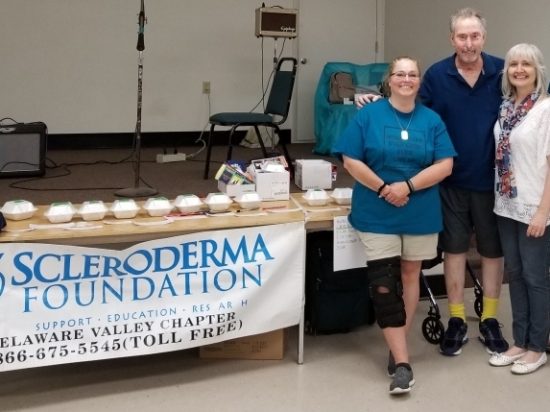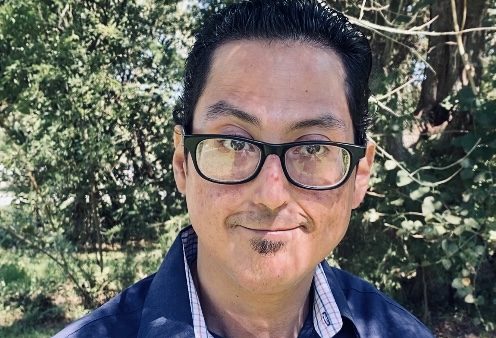The Other 20%: Scleroderma in Males

They’re the elusive red diamonds in a sea of white. Rare upon rare, males with scleroderma make up 20% of scleroderma individuals. Their disease can also manifest uniquely among the community: Males frequently have more muscular and pulmonary involvement — significant pulmonary fibrosis and impaired lung function — than females.
In this column, we ask three men about their journey with scleroderma. All three are active advocates for scleroderma research, funding, and education.
- Michael Bessert, 63, was diagnosed with scleroderma at age 55. He’s celebrating his 40th wedding anniversary with wife, Loretta. Retired from the auto industry, he lives in St. Louis, Missouri.
- Dan Caruso was diagnosed at age 45. Married to Lori with three step children, he lives in Harrisburg, Pennsylvania. Before retiring in 2010, he was a video producer and disc jockey for local events.
- Jacob Vidal Davila, 38, was diagnosed at age 17. He lives in Houston, Texas, and since 2012 has served as a board director for the Scleroderma Foundation’s Texas chapter.
DCW: What have been your major challenges with scleroderma?
MB: Fatigue, loss of muscle mass and strength, dexterity loss in hands, intolerance to cold, getting winded easily. Illness-induced PTSD diagnosis in 2018, depression, anxiety, grief, feelings of failure, loss of camaraderie.
DC: Challenges change as the illness progresses. They’ve ranged from joint pain and Raynaud’s to lung fibrosis, fatigue, and kidney failure. Currently my gastroparesis and fatigue make it difficult to do simple chores. Probably my biggest challenge was recuperating from a double-lung transplant. I spent seven months in the hospital and an additional two months in rehab. Emotionally, the inability to do those things that I used to and now being dependent on others, takes a toll. Being tied to a dialysis machine four days a week also limits one’s ability to travel or even live a normal life.
JVD: Since being diagnosed so young and having my life completely change, my mentality has evolved into a new self-awareness to fully emotionally separate the newly diagnosed and drastic changes that may and ultimately did occur. This has allowed me to disassociate my past pre-scleroderma mentality with my new self, which created a new identify and goals etc. Physically, my hands have curled in dramatically, I can’t open them. It is difficult to manage my daily activities, but I am continuing [to do] my best to be independent and help others in any way I can, especially the scleroderma community.
How would you like to see changes or improvements made in order to better serve males with scleroderma?
MB: Media and marketing is primarily aimed at females. This exclusion adds to males’ lack of understanding. [We need] more information and help addressing mental wellness!
DC: More outreach through support groups and more testing of men by the pharmaceutical companies.
JVD: Everyone needs support [and] males living with scleroderma are no different. Supporting those within a group fashion, first and foremost, is a great avenue for changes and improvements of all kinds. Just imagine the improvements of speaking “face to face” on a virtual call, talking to others about questions and concerns they may be experiencing. It can mean so much to get various feedback and answers for improvements.
How has your journey with scleroderma made you better?
MB: I’m less judgmental [and] more emotional with higher feelings of empathy toward others. I discovered my hidden inner strength.
DC: During the first 10 years of this disease, I tried not to let it define me, but it got to a point where that was no longer possible. I then wanted to define it so that the world would know more about this horrible illness. Becoming an advocate for the foundation gave me an opportunity to meet some terrific people. Starting a support group in Central PA also allowed for this, as well as instilled a sense of purpose.
JVD: Scleroderma has made me revaluate my life goals to help others like myself. It allows me to see into the life of my friends with scleroderma and find ways to possibly create change. Also, it has given me the challenge to bring forth resources and ways to find a cure.
What advice would you give to a male recently diagnosed with scleroderma?
MB: Before they’re overwhelmed, or as I’ve phrased, become “deer in the headlights,” try to find a male patient advocate who’s experienced with newbies.
DC: My advice to a male, or anyone for that matter, would be to not try to put this illness on the back burner. Recognize that it will get worse and the time to deal with it is now through diet and exercise and education.
JVD: It will be OK. Stay active and create a sense of physical self awareness to pinpoint and manage your symptoms as best as possible from day one. You are not scleroderma, so don’t let scleroderma be you.
“The 20%: A Virtual Support Group for Males Living with Scleroderma” launches June 24. Check it out!
***
Note: Scleroderma News is strictly a news and information website about the disease. It does not provide medical advice, diagnosis, or treatment. This content is not intended to be a substitute for professional medical advice, diagnosis, or treatment. Always seek the advice of your physician or other qualified health provider with any questions you may have regarding a medical condition. Never disregard professional medical advice or delay in seeking it because of something you have read on this website. The opinions expressed in this column are not those of Scleroderma News or its parent company, Bionews, and are intended to spark discussion about issues pertaining to scleroderma.










AnaMarie Medina
Wow! That was an eye opening article! I was diagnosed when I was 36 and I'm 53 now. My face and hands have changed dramatically and I also have fatigue and muscle weakness. Raynauds has been the worst of it for me, as I had to have a finger amputated because of an infected ulcer. I've had no one to really talk to about this for so many years aside from doctors, who can really be cold and detached. My family members are kind and considerate by really don't understand the disease and I don't want to explain it because I don't want anyone's pity. I've finally found a support group in NYC. I'm trying to get to the first meeting next month. It will be nice to talk to others who really get it.
Dinah Chong Watkins
Hi AnaMarie! Reynauds is the of the main reasons we moved south, I couldn’t take the cold winters anymore. The Scleroderma Foundation Tri-State Support Group is very active and I encourage you to also contact them. I learned so much from my support group here. Stay warm! Tri-State Support Groups: https://www.scleroderma.org/site/SPageServer/?pagename=ts_support_groups#.YMoh7RpHaf0
Janet
I feel for you, and totally understand what you are going through. I agree with everything you said. I live with constant pain. It's become difficult to get off my bed in the morning. I often cry. Doctors just told me I have the disease, they never explained anything, or told what's next. I had to Google the disease myself to learn and understand more. You are not alone. 🌹🥰🙏🏻